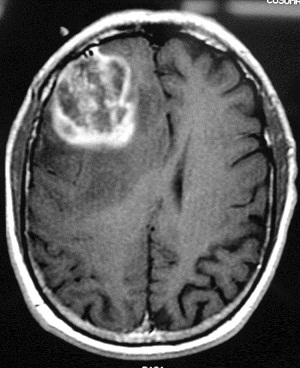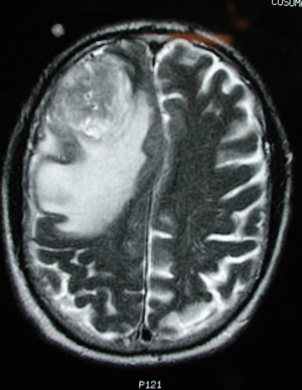Glioblastoma
Original Editors - Simone Potts from Bellarmine University's Pathophysiology of Complex Patient Problems project.
Top Contributors - Simone Potts, Lucinda hampton, Admin, Kim Jackson, Elaine Lonnemann, 127.0.0.1, Wendy Walker and WikiSysop
Introduction[edit | edit source]
Glioblastomas (GBM) are the most common adult primary brain tumor and are aggressive, relatively resistant to therapy, and have a poor prognosis.
- They typically appear as heterogeneous masses centered in the white matter with irregular peripheral enhancement, central necrosis and are surrounded by vasogenic edema.
- Treatment primarily consists of surgery and concurrent radiotherapy and temozolomide.[1]
Epidemiology[edit | edit source]
Glioblastomas usually occur after the age of 40 years (peak incidence between 65 and 75 years of age). There is a slight male preponderance with a 3:2 M:F ratio. Caucasians are affected more frequently than other ethnicities. Approximately 60% of the estimated 17,000 primary brain tumors diagnosed in the United States each year are gliomas. [2]
- The majority of glioblastomas are sporadic.
- Rarely found to be related to prior radiation exposure (radiation-induced GBM).
- They can also occur as part of rare inherited tumor syndromes eg neurofibromatosis type1 (NF1)
Characteristics / Clinical Presentation[edit | edit source]
Presentation is usually in one of the ways listed below:
- Focal neurological deficit
- Symptoms of increased intracranial pressure
- Seizures[1]
Medications[edit | edit source]
- Avastin
- Decadron (dexamethazone) - used to reduce swelling around the tumor
- Dilantin (phenytoin) - used to prevent seizures[3]
- Temozolomide - chemotherapy that slows cancer cell growth
- Vincristine - chemotherapy used in conjunction with other chemotherapy drugs
- Patients with GBM could also be prescribed with a number of different pain medicaions.
Diagnostic Tests / Lab Tests / Lab Value [edit | edit source]
- T1-weighted axial gadolinium-enhanced magnetic resonance image demonstrates an enhancing tumor of the right frontal lobe. Image courtesy of George Jallo, MD. [2]
(Photos courtesy of: Medscape)
- MRI with or without contrast is the study of choice in diagnosing this disease. These lesions typically have an enhancing ring observed on T1-weighted images and a broad surrounding zone of edema apparent on T2-weighted images.
- Currently, no specific laboratory studies are helpful in making a diagnosis of glioblastoma.
- Positron emission tomography (PET) scans and magnetic resonance (MR) spectroscopy can be helpful in identifying glioblastomas in difficult cases, such as those associated with radiation necrosis or hemorrhage. On PET scans, increased regional glucose metabolism closely correlates with cellularity and reduced survival.[4]
- Patients receiving chemotherapy will present with low white blood cell and platelet counts.
T2 weighted image demonstrates the same lesion as in the previous image, with notable edema and midline shift. This finding is consistent with a high-grade or malignant tumor.
.
Etiology / Causes[edit | edit source]
The etiology of glioblastoma remains unknown in most cases. Familial gliomas account for approximately 5% of malignant gliomas, and less than 1% of gliomas are associated with a known genetic syndrome.
Although concerns have been raised regarding cell phone use as a potential risk factor for development of gliomas, study results have been inconsistent, and this possibility remains controversial. The largest studies have not supported cell phone use as a cancer risk factor.
However, a recently released multinational report concluded that studies that are independent of the telecom industry show that cell phone use may pose a significant risk for brain tumors, and some European countries have taken steps to limit cell phone use by children.[2]
Systemic Involvement[edit | edit source]
Systemic complications include gastritis, pneumonia, sepsis, DVT and pulmonary embolism.
According to Dr. R. Sawaya, in the journal "Neurosurgery," systemic complications occur in approximately eight percent of patients undergoing craniotomy for tumor[5].
Medical Management[edit | edit source]
Surgery
- Biopsies
- Partial Resection / Debulking
- Reconstruction (Photo courtesy of: The Lance Armstrong Foundation)
Radiation
- Traditional Teletherapy - marks made on skin where radiation is delivered
- Brachytherapy - surgically implanted radioactive beads
Chemotherapy
- Can be used in conjunction with radiation
- Patient will become immunodeficient
There are many experimental treatment techniques being developed in hopes to rid patients of GBM tumors. Some of these treatment options are not yet FDA approved. An example of an experimental treatment is: an MRI-guided laser interstitial thermal therapy system called AutoLITT.
(Photo courtesy of: The Internet Journal of Emerging Medical Technologies)
Standard treatment is surgery followed by radiation therapy or a combination of radiation therapy and chemotherapy. If surgery is not an option, the doctor may administer radiation therapy followed by or combined with chemotherapy. Many clinical trials using radiation, chemotherapy, or a combination are available for initial and recurrent GBM. Clinical trials using molecularly targeted therapies showing success in other cancers are also being tested in GBM patients. [6]
Upon initial diagnosis of glioblastoma multiforme (GBM), standard treatment consists of maximal surgical resection, radiotherapy, and chemotherapy with temozolomide.[7]
Physical Therapy Management[edit | edit source]
No universal restrictions on activity are necessary for patients with glioblastomas. The patient's activity depends on his or her overall neurologic status. The presence of seizures may prevent the patient from driving. In many circumstances, physical therapy and/or rehabilitation are extremely beneficial. Activity is encouraged to reduce the risk of deep venous thrombosis.[7]
A physical therapist may be consulted to assess functional status and provide treatment aimed at maximizing independence and functional capacity. Home or out-patient physical therapy may be recommended to continue to maximize functional mobility. If intensive physical therapy is required, patients may benefit from an inpatient stay at a rehabilitation hospital. Physical therapy evaluation includes identifying what areas may be limiting function: strength, balance, endurance, pain. The physical therapist may prescribe individualized exercises to address the above areas, and may recommend adaptive equipment.[3]
Exercise is good for GBM patients as long as it is to the patient's tolerance. Functional strengthening and aerobic training should be progressed slowly. These patients will benefit greatly from low intensity exercise. Physical therapists should establish the patient's pulmonary function and fitness level (especially if the patient becomes deconditioned after surgery and/or diagnosis).
Patient and family education is crucial to the improvement of each case of GBM. Each patient needs to be made aware of the symptoms, progression and treatment of this cancer.
Differential Diagnosis[edit | edit source]
- Anaplastic astrocytoma
- Cavernous malformation
- Cerebral abscess
- CNS lymphoma
- Encephalitis
- Intracranial hemorrhage
- Metastasis
- Oligodendroglioma
- Radiation necrosis
- Toxoplasmosis[4]
Case Reports / Case Studies[edit | edit source]
- Glioblastoma Multiforme: A Case Study [view case study in The Internet Journal of Advanced Nursing Practice]
- Case Study: Glioblastoma Multiforme [view case study at Medicor Cancer Centres]
- Well-Circumscribed, Minimally Enhancing Glioblastoma Multiforme of the Trigone: A Case Report and Review of the Literature [view article in the American Journal of Neuroradiology]
- Case-Control Study of Use of NSAIDs and GBM [view case study in the American Journal of Epidemiology]
Resources[edit | edit source]
- Proceedings of the National Academy of Sciences: http://www.ncbi.nlm.nih.gov/pmc/articles/PMC33993/
- American Brain Tumor Association: http://www.abta.org
- American Cancer Society, Inc.: http://www.cancer.org
- National Cancer Institute: http://www.cancer.gov
- National Brain Tumor Society: http://www.braintumor.org
- MGH Brain Tumor Center: http://brain.mgh.harvard.edu/ [(617) 724-8770]
References[edit | edit source]
- ↑ 1.0 1.1 Radiopedia Glioblastoma Available: https://radiopaedia.org/articles/glioblastoma-idh-wildtype?lang=us(accessed 11.5.2022)
- ↑ 2.0 2.1 2.2 Glioblastoma Multiforme (background). Medscape. Available at http://emedicine.medscape.com/article/283252-overview. Accessed March 29, 2011.
- ↑ 3.0 3.1 Glioblastoma multiforme and anaplastic gliomas: A patient guide. Massachusetts General Hospital (Brain Tumor Center). Available at http://brain.mgh.harvard.edu/patientguide.htm. Accessed March 31, 2011.
- ↑ 4.0 4.1 Glioblastoma Multiforme (background). Medscape. Available at http://emedicine.medscape.com/article/283252-diagnosis. Accessed March 29, 2011.
- ↑ Glioblastoma Multiforme Surgery Complications. Livestrong.com. Available at http://www.livestrong.com/article/190510-glioblastoma-multiforme-surgery-complications/. Accessed April 1, 2011.
- ↑ Glioblastoma Multiforme (GBM). National Brain Tumor Society. Available at http://www.braintumor.org/patients-family-friends/about-brain-tumors/tumor-types/glioblastoma-multiforme.html?gclid=CNGRyOuN2KcCFSVe7AodwCdk8Q. Accessed March 29, 2011.
- ↑ 7.0 7.1 Glioblastoma Multiforme Treatment & Management (medical care). Medscape. Available at http://emedicine.medscape.com/article/283252-treatment. Accessed April 3, 2011.









